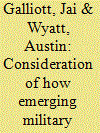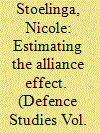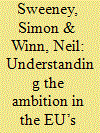|
|
|
Sort Order |
|
|
|
Items / Page
|
|
|
|
|
|
|
| Srl | Item |
| 1 |
ID:
185349


|
|
|
|
|
| Summary/Abstract |
The rapidly emerging scholarly literature responding to autonomous weapon systems has come to dominate our perceptions of future warfare. Scientists, governments, militaries, and civil society organisations continue to debate how to respond to their development. This paper draws on empirical data to consider how emerging defence leaders in the Australian Defence Force perceive major elements and questions within the autonomous weapon system literature. In doing so, this paper offers a data-driven end-user interpretation of the potential interactions between military officers and the autonomous weapon systems they may be asked to oversee. In the absence of a pre-emptive ban under international law, this paper presents a call for greater engagement with junior military leadership as a tool for analysing the assumptions made by policy makers and politicians on this issue.
|
|
|
|
|
|
|
|
|
|
|
|
|
|
|
|
| 2 |
ID:
185350


|
|
|
|
|
| Summary/Abstract |
In a time of rising threat, recurring discussions about burden sharing within NATO and twenty years after the start of the “war on terrorism,” I explore a novel idea in the field of alliance and defense spending: the effect of alliance membership on defense spending in response to a threat. Instead of estimating the determinants of defense spending or burden sharing among members, this paper focuses on two types of states (small and large) and how alliance membership shapes their response to threat. Using the synthetic control method, I create a comparison unit for each type consisting of a weighted average of non-NATO, European countries. 2001 is considered as the starting year of widespread threat, caused by a sudden increase in transnational terrorism. This way, I can estimate the “alliance effect.” I find that both types of states have stronger (positive) response to threat as NATO members, compared to if they would not have been part of the alliance.
|
|
|
|
|
|
|
|
|
|
|
|
|
|
|
|
| 3 |
ID:
185347


|
|
|
|
|
| Summary/Abstract |
Many conceptualizations of homeland security posit a rigid division between national security, which focuses on global threats and challenges at the systemic level, and homeland or domestic security, which focuses on internal threats and challenges inside a state. Thus, in the United States, Iran is a national security threat, while human trafficking or natural disasters are homeland security threats and challenges. The American conceptualization has come to dominate much of the academic literature and curriculum on homeland security. Analysis of courses in domestic and homeland security in the Middle East shows that an American model of homeland security is a frequent export of American-style education. However, this artificial division is not relevant for small states, even aspiring regional powers, because their security priorities overlap the domestic and international. A case study of the United Arab Emirates demonstrates that its key security priorities are shaped by both domestic and global inputs, and require solutions at both levels. However, many courses on domestic and homeland security in the Emirates do not reflect this reality. In studying and teaching security in non-superpowers, the homeland security concept should be updated to properly fit the strategic context of a small state in theory and practice.
|
|
|
|
|
|
|
|
|
|
|
|
|
|
|
|
| 4 |
ID:
185346


|
|
|
|
|
| Summary/Abstract |
The paper analyses the Concept Development and Experimentation (CD&E) approach which has been developed and implemented in NATO over the last 20 years. NATO’s CD&E approach is explained as an organisational innovation and institutional response to external and internal pressures. Within the theoretical framing of institutional isomorphism, the paper analyses the adoption of CD&E in the European Union’s (EU) Common Security and Defence Policy (CSDP). The research hypothesis is that the EU will adopt and apply NATO’s CD&E approach in the EU’s defence planning and capability development process. The empirical findings from the analysis of the EU policy practice, however, show that CD&E has actually been adopted from NATO and applied by the EU to a very limited extent. The low degree of isomorphism between NATO and the EU with regard to applying CD&E is explained by a complex set of factors. The research results have broader implications, suggesting that under the current institutional settings it is highly unlikely CD&E to be adopted by other international organisations in the field of international security.
|
|
|
|
|
|
|
|
|
|
|
|
|
|
|
|
| 5 |
ID:
185342


|
|
|
|
|
| Summary/Abstract |
This article examines the development and performance of formal organisational learning processes in the Ukrainian Armed Forces (UAF) during the Donbas War (2014-present). Through original empirical research conducted with UAF personnel and documentary analysis, the article develops understanding about the detail of UAF lessons-learned processes and their effectiveness in helping to recalibrate UAF activities to operational demands. The article finds that the performance of UAF lessons-learned processes during the Donbas War has, on the whole, been poor. Since the escalation of Russian aggression in 2014, some positive steps which have been taken to implement best-practices in UAF lessons-learned processes. However, the article uncovers a number of organisational activities, structures and processes which could be improved to weaken the negative impact of bureaucratic politics and organisational culture on learning. It concludes with recommendations for the further development of UAF lessons-learned processes. The article highlights the particular importance of improving the capacity of the civilian leadership to exert effective oversight of military learning and of US and NATO support for these efforts.
|
|
|
|
|
|
|
|
|
|
|
|
|
|
|
|
| 6 |
ID:
185344


|
|
|
|
|
| Summary/Abstract |
The term “Hybrid Warfare” has been defined and redefined in multiple diverse manners in the past two decades. Conventionally the concept of Hybrid Wars referred to a combination of regular and irregular forces to obtain synergy on the battlespace. However, following the Russian annexation of Crimea and the destabilization of Eastern Ukraine, the Western community has revisited the definition of Hybrid Wars and reconceptualized it. Interestingly, this term is approached by Russia and the West in quite a different style, as per their own purpose, i.e Russia claims to be a victim of Hybrid Wards waged by the West. This research investigates the philosophy of the two mentioned versions of Hybrid Warfare and finds both irrelevant to comprehend Russia’s wars in the post-Soviet geography. Instead, it suggests to retreat to the original definition of hybrid warfare, in the context of Ukraine and Georgia cases and thereby argues that Russia performs hybrid warfare to restrict foreign policy maneuverabilities of the former Soviet republics.
|
|
|
|
|
|
|
|
|
|
|
|
|
|
|
|
| 7 |
ID:
185345


|
|
|
|
|
| Summary/Abstract |
The quest for substance, capability, and strategic autonomy goes on – or does it? Is the objective of CSDP territorial defence and strategic autonomy, or crisis management and softer security concerns like peacekeeping, border management, protection of shipping lanes, and/or cyber security? The Union needs to move beyond familiar complaints about the lack of common strategic culture and EU intrusion into NATO responsibilities. Geostrategic and economic imperatives dictate that the EU should progress CSDP beyond civilian crisis management in the EU Neighbourhood, and military training and security sector reform (SSR). The Strategic Compass must signal CSDP clarity of objectives, coherence, enhanced capability, and appropriate burden sharing with NATO. The response to the Strategic Compass must build European strategic autonomy in ways that strengthen NATO. For military strategic and economic reasons, both the EU and the post-Brexit UK need intensive cooperation to maintain their geostrategic relevance and strengthen the NATO alliance. This paper reflects on prospects for the EU Strategic Compass and offers timely analysis of recent trends in EU foreign and security policy and expresses cautious optimism regarding the enhanced European strategic autonomy/actorness.
|
|
|
|
|
|
|
|
|
|
|
|
|
|
|
|
|
|
|
|
|